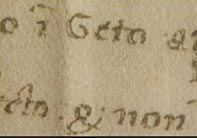Find out more about The Open University's Religious Studies courses and qualifications
 In Renaissance Europe, Jews were seen as a threat to Christianity. Jews had been evicted from England in the 1290s, and were forced out of many other European states in the fifteenth and sixteenth centuries.
In Renaissance Europe, Jews were seen as a threat to Christianity. Jews had been evicted from England in the 1290s, and were forced out of many other European states in the fifteenth and sixteenth centuries.
In those few places where they were tolerated, such as Venice, it was under sufferance, and only because they were useful.
Venetian laws restricted Jews from working in certain professions such as manufacturing, so they were forced into alternative professions. Fear of Jews was compounded by envy of their success as doctors, merchants and bankers. As moneylenders, Jews played an important part in the Venetian economy. They were also a convenient source of taxation. But the Venetian desire to limit their contact with Christians resulted in the creation in 1516 of a "Jewish ghetto", a specific neighbourhood of Venice. Several thousand Jews were crammed into tall buildings in this small walled area; access to the rest of the city was restricted.
Despite the prejudice against Jews, Patricia found an account of Christian neighbours of the ghetto raising the alarm when seeing burglars in the area. She concludes that despite restrictions Venetian Jews were relatively protected and safe.
Evidence
 There's a document in the state archives relating to the setting up of the ghetto. It was established in 1516 and politicians ruled that gates had to be shut overnight and manned by Christian guards paid by the Jews inside.
There's a document in the state archives relating to the setting up of the ghetto. It was established in 1516 and politicians ruled that gates had to be shut overnight and manned by Christian guards paid by the Jews inside.
Coryat: "I saw many Jewish women, whereof some were as beautiful as ever I saw, and so gorgeous in their apparel...that some of our English Countesses do scarce exceede them".
The account of the neighbours raising the alarm when burglars were loading goods stolen from the ghetto into a boat was taken from the trial records, which can be found in the State Archives. It included reports of the testimony of the witnesses and of the accused, and is quite detailed.
Jews were seen as a threat to Christianity, and in Venice a ghetto was created. But despite this, there appears to be evidence of Venetian Jews being protected.
 Thinking History
Thinking History
Why did the authorities want to protect the Jews?
Jews in Venice offered useful credit facilities. It is not the case that Christians were prevented from providing financial services. Christians were not supposed to lend money at interest (stigmatised as usury), but there was plenty of creative accounting in order to get around this rule, for example by claiming that a service was being provided with the loan, and in fact Christian banking houses were completely uninhibited by the usury laws. Jews were useful because they were prepared to lend to the very poor. The programme tells us that in times of economic difficulty, as in the early 16th century, steps were taken to foster the Jewish community; by providing credit to high risk groups Jews could help boost consumer spending. But did this relative tolerance last? Later in the 16th century life became much more difficult for Venetian Jews.
Depending on the economic and cultural climate of the day, the Jewish community was either fostered or hounded. Venice, amongst the cities in Europe, was not unique in this regard.



Rate and Review
Rate this article
Review this article
Log into OpenLearn to leave reviews and join in the conversation.
Article reviews
I'm proposing the Tolerance is conditional on 3 things: we dont like something, we feel it has less value, and we tolerate only until we can do something to change, remove or stop it.
The article mentioned "But did this relative tolerance last? Later in the 16th century life became much more difficult for Venetian Jews.", which implies condition three was activated.
What were the circumstances around this change in situation and behaviour towards the Jewish community?
Many thanks in advance - I note this article is many years old, but hopeful of a response.
Kind regards, Andrew